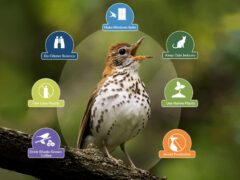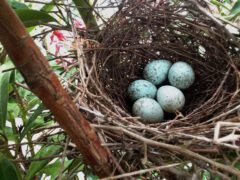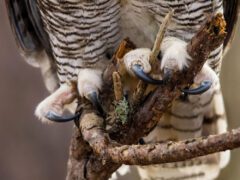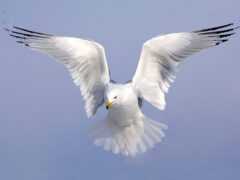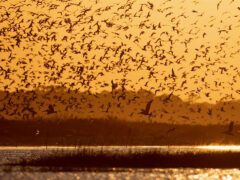Western Sandpiper Similar Species Comparison
Main SpeciesWestern Sandpiper
Breeding adult
Small, portly sandpiper with black legs and a black slightly drooping bill. Breeding birds have a rusty cap and rusty mottling on the back.
© Dorian Anderson / Macaulay LibraryCalifornia, April 16, 2020Nonbreeding adult
Small, rather chunky shorebird. The bill is long and slightly drooping, although bill length and shape is quite variable among individuals and is not diagnostic on its own. Nonbreeding birds have little streaking on the breast.
© Mike Cameron / Macaulay LibraryTexas, January 26, 2019Breeding adult
Tiny shorebird; feeds on aquatic invertebrates usually at the water's edge or in shallow standing water. Appears somewhat front-heavy; folded wings are same length as tail.
© Benjamin Clock / Macaulay LibraryAlaska, May 27, 2009Juvenile
Juveniles look like nonbreeding adults but have a more scaly-looking back with a whiter face.
© Ian Davies / Macaulay LibraryWashington, September 19, 2020Nonbreeding adults
Tiny shorebird with whitish face and little streaking on the breast. Often forages by probing into mud and sand at water's edge.
© Timothy Barksdale / Macaulay LibraryCalifornia, February 01, 1997Juvenile
In flight, rusty shoulder bars on juveniles can be seen at close range. As in most other "peep" sandpipers, note black stripe down the center of the tail.
© Blair Dudeck / Macaulay LibraryBritish Columbia, October 01, 2018Breeding adult
Small, portly sandpiper with black legs and a black bill. Looks rather large headed compared to similar species. Breeding adults have rusty highlights in the head and shoulders.
© Brooke Miller / Macaulay LibraryAlaska, May 06, 2015Juvenile
Juveniles have crisp scaly markings on the back as a result of their newly grown feathers. They also show a rusty bar on the shoulder at a time when adults are in their brown-and-white nonbreeding plumage.
© Timothy Barksdale / Macaulay LibraryKansas, August 01, 1995Nonbreeding adult
Small shorebird with a short neck and larger head. Nonbreeding birds are grayish above and white below. Often forages with its head even with or above the body.
© Chris Wood / Macaulay LibraryNew York, September 20, 2008Breeding adult
Breeding birds have a rusty cap and rusty mottling on the back. From a distance its whiter face stands out.
© Tim Lenz / Macaulay LibraryAlaska, May 19, 2012Flock
Often seen on migration and wintering grounds in large flocks, sometimes with other "peep" species.
© Timothy Barksdale / Macaulay LibraryWashington, January 01, 1994Habitat
Breeds in tundra with dwarf vegetation. Migrates and winters along mudflats, beaches, shores of lakes and ponds, and flooded fields.
© Jennifer O'Neill / Macaulay LibraryWashington, April 29, 2017Similar SpeciesSemipalmated Sandpiper
Breeding adult
Semipalmated Sandpipers have a smaller head and a slimmer-bodied look than Western Sandpipers. In breeding plumage, Semipalmated Sandpipers have duller rusty upperparts, a darker face, and cleaner flanks than Westerns.
© Davey Walters / Macaulay LibraryMassachusetts, June 03, 2015Similar SpeciesSemipalmated Sandpiper
Nonbreeding adult
Semipalmated Sandpipers have a smaller head, a slimmer-bodied look, and often a shorter bill than Western Sandpipers. Nonbreeding birds tend to be browner than Westerns, which are more gray, but they can be difficult to readily separate in the field.
© Jonathan Eckerson / Macaulay LibraryMassachusetts, July 16, 2017Similar SpeciesLeast Sandpiper
Breeding adult
Least Sandpipers are slightly smaller than Western Sandpipers with yellow (not black) legs and a browner and smudgier breast.
© Evan Lipton / Macaulay LibraryMassachusetts, May 19, 2016Similar SpeciesLeast Sandpiper
Nonbreeding adult
Nonbreeding Least Sandpipers have yellow, not black legs like Western Sandpipers. Their breast is also browner and smudgier than Western Sandpipers.
© Ian Davies / Macaulay LibraryGeorgia, September 28, 2016Similar SpeciesBaird's Sandpiper
Adult
Baird's Sandpipers are larger with a longer and straighter bill than Western Sandpipers. They also have darker faces than Westerns and more smudging on the breast.
© Brian Sullivan / Macaulay LibraryNew York, August 02, 2005Similar SpeciesBaird's Sandpiper
Juvenile
Baird's Sandpipers are large than Western Sandpipers. Their long wings extend farther past the end of the tail than they do on Western Sandpipers. Also note darker face and breast on Bairds than Westerns.
© Dorian Anderson / Macaulay LibraryMassachusetts, August 17, 2013Similar SpeciesWhite-rumped Sandpiper
Molting adult
White-rumped Sandpipers are larger with a darker breast than Western Sandpipers. Their face also appears darker than the whitish face of Western Sandpipers. In flight, note the white rump that Westerns lack.
© Dorian Anderson / Macaulay LibraryMassachusetts, September 11, 2011Similar SpeciesSanderling
Breeding adult
Sanderlings are larger with a thicker bill than Western Sandpipers. Breeding Sanderlings have a chestnut neck while breeding Westerns have a whitish streaked neck.
© Jonathan Lugo / Macaulay LibraryVirginia, May 26, 2016Similar SpeciesSanderling
Nonbreeding adult
Sanderlings are larger with a thicker bill than Western Sandpipers. Nonbreeding birds often show a darker shoulder bar that Westerns do not have. They also have cleaner and whiter underparts than Westerns.
© Ryan Schain / Macaulay LibraryMassachusetts, November 16, 2014Compare with Similar Species
Click on an image to compare
Species in This Family
Sandpipers and Allies(Order: Charadriiformes, Family: Scolopacidae)
More to Read
Don't miss a thing! Join our email list
The Cornell Lab will send you updates about birds,
birding, and opportunities to help bird conservation.




































